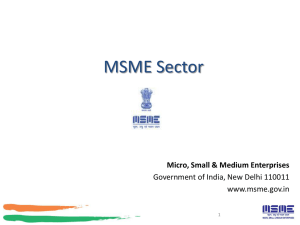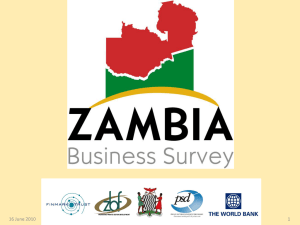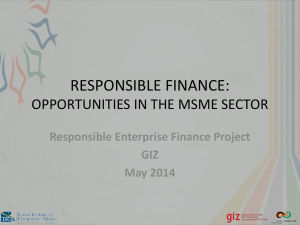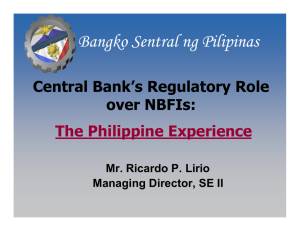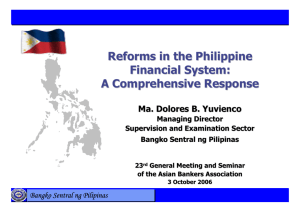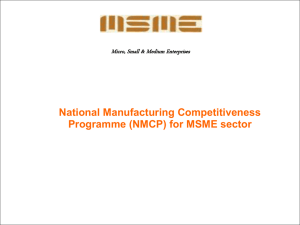LAGUA-Proportionate-Regulatory-Policies-for-the-MSME
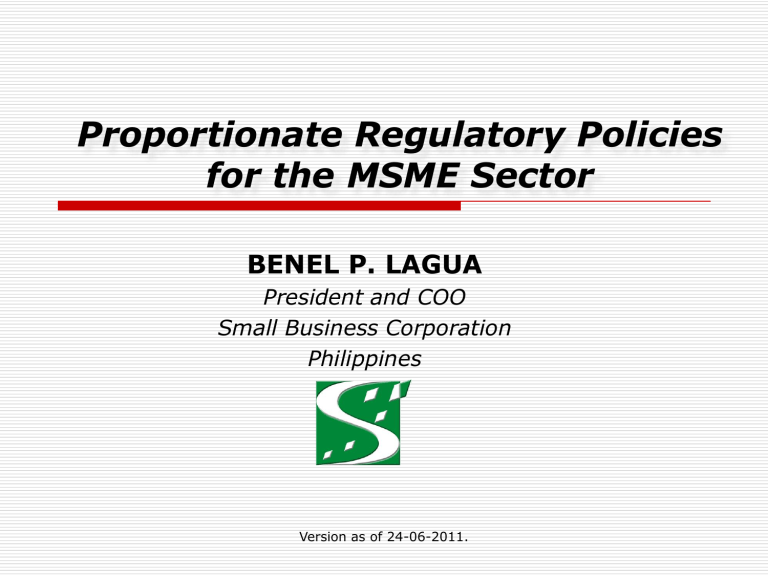
Proportionate Regulatory Policies for the MSME Sector
BENEL P. LAGUA
President and COO
Small Business Corporation
Philippines
Version as of 24-06-2011.
Presentation Outline
1.
Importance of MSME Sector
2.
Role of Government
3.
General Practices on Proportionate
Regulatory Policies
4.
The Philippine Response
5.
Policy Execution
6.
Conclusion
*The views expressed herein are the author’s and do not necessarily reflect the position of the Small Business Corporation.
Importance of MSME Sector
The economic impact of MSMEs:
MSMEs make up 99.6% of total Philippine establishments and makes the following contributions to the Philippine economy
61% of employment
32% of value-added
60% of exports
MSMEs are largely dependent on the banking system for financing
MSMEs are disadvantaged due to size, higher unit transaction cost, perceived risks, and financial infrastructure distortions
The Role of Government in MSME
Development
Facilitate MSMEs’ access to credit from formal institutions by:
Crafting policies that will allow for a borderless credit access by MSMEs and ensuring effective implementation of such policies
Creating a regulatory environment for banks conducive to MSME lending
Capacitating both banks and MSMEs
Absorbing some costs of programs aimed at increasing MSMEs’ access to credit
Addressing market failure, leveling the playing field
Proportionate Policies
“One size does not fit all”
Regulation and supervision can be expensive to implement, and costly when it fails
Need for affirmative action and tiered regulation—
Differing regulatory requirements based on market capitalization
Reduce discrimination
Scale regulatory treatment
General Practices on Proportionate Policies
[World Bank, CSBFA, RBI, SBA, CRA, CGAP]
Guarantee Schemes (more than half of all counties in the world have a guarantee program)
Directed Credit Programs
Interest Rate Subsidies
Regulatory Subsidies, e.g. lower provisioning
Regulations Concerning Documentation
Establishment of Credit Registries to address information asymmetry
Priority Sector Lending, e.g. mandatory credit laws, PSL in India,
Community Reinvestment Act in the USA
The Philippine Response
1.
Magna Carta for MSMEs or RA 9501 (2008)
Required that banks allot at least 8% for micro and small and 2% for medium enterprise in their total loan portfolio
Strengthened the Small Business Corporation, a specialized financing and guarantee institution for
MSMEs
2.
Barangay Micro Business Enterprise (BMBE) Law (2002)
Provides income tax exemption, minimum wage exemption, and other benefits such as special credit window and other forms of assistance programs for micro enterprises
The Philippine Response
3.
Credit Information System Act or CISA (2008) or RA 9510
Mandates the creation of a credit information bureau that will serve as a central registry of repository of credit information including credit history and financial condition of borrowers
Promotes an efficient credit information system that will address financial institutions’ concerns on all their credit-related activities
4.
Bangko Sentral ng Pilipinas (BSP) Regulations and Circulars on SME
Lending
Capital requirements, loan documentation, risk weights
5.
BSP Regulatory Framework on Microfinance:
Encouraged the establishment of microfinance-oriented banks and has a specialized microfinance regulatory unit. This allowed non-collateralized lending to the sector based on cash flow.
In theory, the Philippines is adopting the menu of proportionate regulatory policies.
What is the problem?
Policy Execution
1.
a) Magna Carta for MSMEs or RA 9501 (2008)
On the mandatory credit allocation
Compliance report too broad / Not transparent
Overall, banking sector appear to be compliant with the requirements of the law, but at the margin especially in micro and small—8.5% vs. mandated 8.0%
Individual performance of banks reveal, however, that many big banks remain under-complied
Some banks cover for the deficiency of other financial institutions
Lending figures to micro and small business sector is flat over the past 10 years—Negative real growth is observed.
Moral Hazard problem; Penalty structure for non-compliance is cheap/uniform and biased against smaller banks
Policy Execution
1.
b) Magna Carta for MSMEs or RA 9501 (2008)
On SB Corporation
Self-sustaining. No government infusion in the past 19 years. Declares Dividends.
No sovereign guarantee. Another GFI whose main mandate is guarantee for (large) export firms has a sovereign guarantee feature.
Limited capitalization when benchmarked against guarantee corporations in Asia; multiple objectives.
Recent increased capitalization remains in paper
Supervision not much different from “standard” prudential supervision of banks
Policy Execution
1.
b) Magna Carta for MSMEs or RA 9501 (2008)
On SB Corporation
No clear appreciation of nature of guarantee corporation
Costs incurred by the government in implementing MSME financing programs (e.g credit guarantees) may not be directly recoverable using revenues per se as a measure
Full cost recovery could not be achieved without compromising the objective of facility finance to small business.
Cost-recovery can be measured through the underlying economic impact of MSME programs (i.e taxes for government, productivity, employment, income, economic growth, etc.)…[Canada SBFA Report]
Policy Execution
2.
Barangay Micro Business Enterprise (BMBE) Law
(2002)
Reluctance from executing agencies (i.e DOF and LGUs concerned about losses due to tax exemption granted to BMBEs)
3.
Credit Information System Act or CISA (2008) or RA
9510
Still awaiting full implementation after almost 3 years that the law has been signed
Lack of funds to support the mandate, including the creation of the credit information corporation
Policy Execution
4.
a) Bangko Sentral ng Pilipinas (BSP) Regulations and
Circulars on SME Lending
On Loan Documentation:
Requires the submission of BIR-submitted Income Tax
Return (ITR) upon loan application, including its waiver of confidentiality and its annual submission
Moratorium on submission granted for MSMEs, but to expire in December 2011
After 2011, small business loans without documents to be classified as “especially mentioned”
ITRs rarely reflect true condition of an enterprise. Should the exemption be extended?
Policy Execution
4.
b) Bangko Sentral ng Pilipinas (BSP) Regulations and
Circulars on SME Lending
On loan classification
Reduced risk weight of MSME portfolio from 100% to
75%
Subject to conditions like meeting certain prudential norms, including PDR of not more than 5% and a highly diversified portfolio with not less than 500 accounts
Questions on appropriateness of conditional prudential standards to enjoy risk weight reduction benefit
Policy Execution
4.
c) Bangko Sentral ng Pilipinas (BSP)
Regulations and Circulars on SME Lending
On loan classification
Loans to exports to the extent guaranteed by SBC with 20% risk weight
Loans to exporters to the extent guaranteed by
GFSME with 0% risk weight so long as these are outstanding upon merger
Loans to exporters guaranteed by SBC in postmerger as 20% risk weight though these may be renewals
Is the reduced risk weight sufficient incentive to banks utilizing the guarantee?
Policy Execution
4.
d) Bangko Sentral ng Pilipinas (BSP) Regulations and Circulars on SME Lending
On unsecured loans
In theory, no technical prohibition for granting of loans without collateral except for DOSRI limits
However, an unsecured loan for banks’ risk-based
CAR is a 100% risk weight on capital
Also, in the event the loan turns past due, loan loss provisioning is immediately high
Not eligible for rediscounting
Effectively, there is disincentive to lending without collateral
Policy Execution
4.
e) Bangko Sentral ng Pilipinas (BSP)
Regulations and Circulars on SME Lending
Supported the creation of independent Credit
Surety Fund (CSF) set aside by LGUs
Provides guarantee which secures the loan of
MSMEs with local banks and facilitates lending without collateral
CSFs are too small and without muscle; model is not cognizant of how guarantee programs work
Policy Execution
4.
f) Bangko Sentral ng Pilipinas (BSP) Regulations and
Circulars on SME Lending
Reserve Requirements
PFIs of SB Corp are exempted from reserve requirements by BSP under SBC Wholesale Lending
Program, encouraging banks to expand their MSME loan portfolio
However, BSP also runs its rediscounting window, sometimes at concessionary/subsidized rates, in competition with GFIs’ wholesale lending programs
Policy Execution
5.
Bangko Sentral ng Pilipinas (BSP) Regulatory
Framework on Microfinance
Issuance of circulars governing the practice of microfinance in the banking sector—rediscounting, recognition of microfinance (no collateral, loan documentation), allow branching, etc.
Modified Manual of Examination
Promotion and Advocacy
Philippines cited by EIU as having the best overall regulatory environment for microfinance on banks.
However, BSP does not cover NGOs and cooperatives.
Conclusion
Execution is opaque
Implementing rules not following the spirit of basic law
Under-funded and undersized programs—not commensurate to mandate; unwillingness to make the investment
Inter-agency conflict—apparent weakness in coordination
Business model inconsistent with program objectives
Costs and benefits of some proportionate regulatory schemes not well-measured
Objectives are at cross-purpose
Major changes in Microfinance; Uneven policy execution in SME Finance.
Conclusion
Government intervention by way of proportionate regulatory action must:
Focus on reducing risks and transaction costs associated with MSME lending
Balance the benefits of regulation/supervision against the costs and risks of no regulation/supervision
Aim for consistency across stakeholders and institutions
Conclusion
Government intervention by way of proportionate regulatory action must:
Serve as co-investor, thus, a source of risk capital
Educate private capital on how to lend to SME
(capacity building)
Channel capital in strategic directions
Be designed for effective implementation, execution, and enforcement
Be “enlightened”
References
1.
2.
3.
4.
5.
ADB (2000), “The Role of Central Banks in Asia and the Pacific: Overview”
( http://www.adb.org/Documents/Books/Central_Banks_Microfinance/Overview/chap_
05.pdf
)
Canada Small Business Financing Act (2009), “Comprehensive Review Report 2004-
2009),” [ http://dsp-psd.pwgsc.gc.ca/collections/collection_2010/ic/Iu188-1-2009eng.pdf
]
CGAP (2011), “Recommendations for Proportionate Regulation and Supervision of
Microfinance,” INCITRAL Colloquium on Microfinance
Clinton, Lindsay (2010), “India Journal: What’s Policy Got to Do With Social
Enterprise?” ( http://blogs.wsj.com/indiarealtime/2010/12/06/india-journal-whatspolicy-got-to-do-with-social-enterprise/ )
Fan, Qimiao (The World Bank), Presentation during the “Workshop on Improving
Access to Finance for SMEs in Asia-Pacific Region, June 16-17, 2008 http://blogs.worldbank.org/allaboutfinance http://dnb.com.au/Header/News/Banking_on_SMEs/indexdl_7334.aspx
http://www.philstar.com/Article.aspx?publicationSubCategoryId=66&articleId=697537
6.
7.
8.
9.
Sibold, S. (2005), “Addressing the Burden of Regulation in Canada—The Case for
Proportionate Regulation,”
( http://www.tfmsl.ca/Documents/StephenSiboldPropReg.pdf
)
10.
Thornley, B. et al (2011), “Case 12: Priority Sector Lending,” in Impact Investing, A
Framework for Policy Design and Analysis
( http://www.pacificcommunityventures.org/insight/impactinvesting/report/12-
Priority_Sector_Lending.pdf
)
11.
Wikipedia, Community Reinvestment Act
( http://en.wikipedia.org/wiki/Community_Reinvestment_Act )
END.
